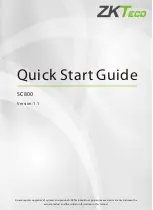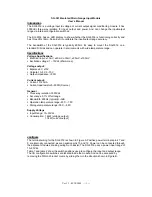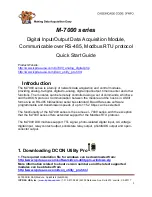
2-1
Section 2
Theory of Operation
VECTOR OUTPUT I/O MODULE OVERVIEW
The 9100A-017 Vector Output I/O Module adds 40 lines of input and
high-speed output capability to the 9100A/9105A mainframe. Up to four
Vector Output I/O Modules may be connected to the mainframe for a
maximum of 160 channels of vector output and stimulus measurement. Any
number of the 160 channels may be used simultaneously.
The Vector Output I/O Module has the same input measurement capabilities
as the 9100A-003 Parallel I/O Module. The Vector Output I/O Module is
capable of generating cyclic redundancy checks (CRCs), measuring
frequency or taking event counts, and recording logic level histories.
The input measurements can be synchronized to the 9100A/9105A
microprocessor-specific Pod, to external events (using the module
external START, STOP, ENABLE, and CLOCK lines), to a software strobe, or
to a free-running clock. The input section may also be synchronized to
the output section by using the Capture Clock (a user-programmable clock
generated during vector driving). The module also has a programmable
“breakpoint” capability. The input thresholds may be set to either “TTL”
and “CMOS” levels.
The Vector Output I/O Module can drive vector patterns synchronized to a
user-supplied external clock (at up to 25 MHz), to a user-selectable
internal clock at 1, 5, 10, or 20 MHz, to a software strobe, or to the
Pod. The output can be latched to a level (either high or low) on any of
the module’s lines to test devices using either a “writeword” or
“writepin” command. Each pin can be driven either high or low, or be
tri-stated. An external input is available to provide handshaking
synchronization with the UUT. All 40 outputs can be simultaneously
tri-stated by an external signal.
The Vector Output I/O Module consists of two assemblies: the Main PCA
(9100A-4021) and the Top PCA (9100A-4022).
The Main PCA provides the interface to the mainframe, and is used for
input measurements. The Main PCA includes the inputs for the external
synchronization lines START, STOP, ENABLE, and CLOCK. It also contains
some support circuitry for vector driving, including:
o bus interfacing circuitry for the Top PCA.
o vector drive internal clock control.
o vector loop control circuitry.
Summary of Contents for 9100 Series
Page 6: ... iv ...
Page 8: ... vi ...
Page 15: ...2 Theory of Operation 2 3 Figure 2 1 Input Section Functional Block Diagram ...
Page 16: ...2 Theory of Operation 2 4 Figure 2 2 Output Section Functional Block Diagram ...
Page 19: ...2 Theory of Operation 2 7 Figure 2 3 Input Section Address Decoding Summary ...
Page 42: ...2 Theory of Operation 2 30 ...
Page 50: ...4 List of Replaceable Parts 4 2 ...
Page 54: ...4 List of Replaceable Parts 4 6 Figure 4 1 9100A 017 Final Assembly ...
Page 55: ...4 List of Replaceable Parts 4 7 Figure 4 1 9100A 017 Final Assembly cont ...
Page 57: ...4 List of Replaceable Parts 4 9 Figure 4 2 A1 Main PCA ...
Page 59: ...4 List of Replaceable Parts 4 11 Figure 4 3 A2 Top PCA ...
Page 64: ...4 List of Replaceable Parts 4 16 ...
Page 66: ...5 Schematic Diagrams 5 2 ...
Page 67: ...5 Schematic Diagrams 5 3 Figure 5 1 A1 Main PCA ...
Page 68: ...5 Schematic Diagrams 5 4 Figure 5 1 A1 Main PCA cont ...
Page 69: ...5 Schematic Diagrams 5 5 Figure 5 2 A2 Top PCA ...
Page 70: ...5 Schematic Diagrams 5 6 Figure 5 2 A2 Top PCA cont ...
Page 74: ...Index Index 4 ...














































